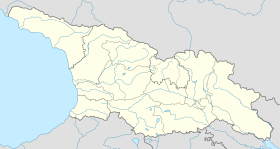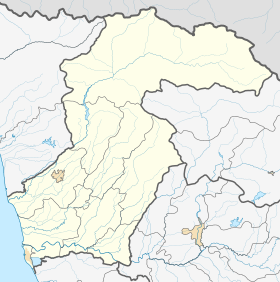Abasha
აბაშა | |
|---|---|
Town | |
 Abasha's main street | |
| Coordinates: 42°12′15″N 42°12′10″E / 42.20417°N 42.20278°E | |
| Country | |
| Region | Samegrelo-Zemo Svaneti |
| District | Abasha |
| Elevation | 23 m (75 ft) |
| Population (2024)[1] | |
| • Total | 4,225 |
| Time zone | UTC+4 (Georgian Time) |
| Website | abasha.ge |
Abasha (Georgian: აბაშა) is a town in western Georgia with a population of 4,941.[2] It is situated between the rivers of Abasha and Noghela, at 23m above sea level and is located some 283 km (176 mi) to the west of Tbilisi. The settlement of Abasha acquired the status of a town in 1964 and currently functions as an administrative center of the Abasha Municipality within the Samegrelo-Zemo Svaneti region. The headquarters of the Georgian Orthodox Eparchy of Chkondidi is also located in Abasha.
The modern history of Abasha is primarily associated with a resonant Soviet-era economic experiment introduced by the Georgian Communist party chief Eduard Shevardnadze in the 1970s. In 1971, Shevardnadze grouped all regional agricultural institutions, including the kolkhoz, into a single management association. At the same time, those who worked on the land received material and financial preference. The move facilitated local initiative and coordination and led to a rapid increase in agricultural production in the previously very poor Abasha District. It had been the first private enterprise in the Soviet Union since Lenin. Early in the 1980s, the "Abasha experiment" was expanded, with varying degrees of success, to other regions of Georgia.[3]
- ^ "Population by regions". National Statistics Office of Georgia. Retrieved 29 April 2024.
- ^ "Population Census 2014". www.geostat.ge. National Statistics Office of Georgia. November 2014. Retrieved 28 June 2021.
- ^ Suny, Ronald Grigor (1994), The Making of the Georgian Nation: 2nd edition, page 312. Indiana University Press, ISBN 0-253-20915-3



